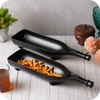

I’ll never forget the day I swapped out a boring plastic pot for a gorgeous ceramic one—it was like giving my fiddle-leaf fig a glow-up! If you’re a plant lover like me, you’ve probably agonized over which pot is best for your green babies. Plastic, terracotta, metal—the options are endless, but ceramic pots always seem to steal the show. So, why use ceramic pots for plants? Why do I rave about them to anyone who’ll listen? In this post, I’m spilling the tea on the benefits of choosing ceramic planters, from their drop-dead gorgeous looks to how they keep your plants thriving. Whether you’re greening up your office, home, or community garden, here’s why ceramic pots might just become your new obsession.
They’re Basically Plant Jewelry
Let’s talk about the wow factor. One of the best benefits of choosing ceramic planters is how they turn any corner into a vibe. These pots come in every color and style under the sun—glossy blues for that sleek, modern look, earthy textures for cozy feels, or hand-painted designs that scream “I’m one of a kind.” Plastic pots? They’re like the plain toast of the plant world. Ceramic pots? They’re the artisanal sourdough with all the toppings.
I’ll never forget the day I brought home a mustard-yellow ceramic pot for my monstera. It was like my living room went from “meh” to “magazine-worthy” overnight. For our internal blog crew—whether you’re an employee jazzing up your desk or part of a community garden project—ceramic pots are like a warm hug for shared spaces. They make the office lounge or a community patio feel inviting, like everyone belongs there.


They Keep Your Plants Cozy and Happy
Plants can be drama queens, right? Too hot, too cold, and they’re dropping leaves like it’s nobody’s business. That’s where ceramic pots save the day. A huge reason why use ceramic pots for plants is how they keep roots happy. These pots, made from thick, fired clay, are like a thermos for soil, buffering it from crazy temperature swings. Plastic pots turn into mini saunas in the sun, scorching roots. Ceramic? It’s like a steady, reliable friend.
I learned this when my outdoor succulents nearly gave up the ghost in plastic pots during a heatwave. Switching to ceramic was a game-changer—they’ve been thriving ever since. For plants like ferns or peace lilies that crave steady moisture, ceramic holds water longer than terracotta, so I’m not chained to my watering can. For our busy internal audience—maybe you’re juggling meetings or tending a shared garden—this means less stress and more time to admire your green babies.


They Let Roots Breathe (But Not Too Much)
Another reason I’m head over heels for the benefits of choosing ceramic planters is their Goldilocks-level balance of air and moisture. Ceramic is naturally porous, letting just enough air flow to keep roots healthy and prevent that dreaded root rot. This is a lifesaver for my orchids and cacti, which hate wet feet. But unlike terracotta, which dries out faster than my phone battery, ceramic pots—especially glazed ones—keep things just moist enough for plants like my peace lily.
Pro tip from my plant-parent fails: always check for drainage holes. I once overwatered a glazed ceramic pot with no holes and nearly drowned my poor aloe. Now I use saucers or a gritty soil mix to keep things in check. For our internal blog readers, this makes ceramic pots perfect for mixed plant collections in the office or community spaces, from low-key succulents to lush tropicals.
They’re Tough as Nails (Well, Almost)
Ceramic pots are the unsung heroes of durability. Another reason why use ceramic pots for plants is that they’re built to last. Plastic pots fade and crack in the sun, and metal ones rust faster than you can say “rainy season.” Ceramic? It laughs in the face of weather. I’ve got a teal ceramic pot on my balcony that’s been through storms, heatwaves, and my clumsy watering routine, and it still looks like it just rolled out of the kiln.
Their weight is a bonus, too—no more toppling disasters with my top-heavy dracaena. This is clutch in shared spaces where kids, pets, or that one coworker who flails their arms (you know who you are) might knock things over. Sure, they’re a bit heavy to move, but for a pot that’s this pretty and sturdy, I’m cool with it.
They’re a High-Five to the Planet
I’m a sucker for eco-friendly choices, and ceramic pots are my kind of green. One of the benefits of choosing ceramic planters is their planet-loving vibe. Made from natural clay—a renewable resource—they’re a far cry from plastic pots that clutter landfills or leach weird stuff into the soil. Many are reusable, recyclable, and safe for growing herbs or microgreens (just check that the glaze is food-safe).
Their long life means I’m not buying new pots every year, which my wallet and the earth appreciate. I started using ceramic in our office’s green team project, and it’s been a hit—cleaner air, happier plants, and a nod to sustainability. For our internal audience, ceramic pots are a no-brainer for company eco-goals or community spaces aiming to keep things green and gorgeous.
They’re as Unique as You Are
Ceramic pots are like the choose-your-own-adventure of planters. Whether you’re potting a tiny jade or a towering bird of paradise, there’s a ceramic pot that fits. Small ones are perfect for desk plants in the office, while bigger ones keep large plants steady. This versatility is a big reason why use ceramic pots for plants—they work for every plant and every personality.
I’m obsessed with artisanal ones, like the hand-painted Mexican pot I snagged at a local market. It’s like my plants are wearing custom outfits! For our internal blog readers, mix and match colors and textures to show off your team’s vibe or your company’s brand. It’s a fun way to spark joy in shared spaces, whether it’s a community garden or an office greenery nook.
Keeping Your Ceramic Pots Happy
To keep the benefits of choosing ceramic planters flowing, a little love goes a long way. Here’s what I’ve learned from my plant-parent journey:
Drainage Matters : Check for holes to avoid soggy roots. No holes? Grab a saucer or use well-draining soil.
Winter TLC : Ceramic can crack in freezing weather, so bring outdoor pots inside or wrap them up.
Keep ‘Em Fresh : Wipe glazed pots with a damp cloth to keep them sparkling. Soak unglazed ones before planting to prep the clay.
Saucers Save Surfaces : In shared spaces, saucers protect desks and floors, especially for glazed pots that hold more water.
These tips are perfect for our internal crew, making it easy to keep office or community plants thriving without breaking a sweat.
Any Catch?
Ceramic pots aren’t flawless. They can cost more than plastic or terracotta, which might sting if you’re on a budget. They’re heavy, so rearranging is a mini workout, and they can shatter if you’re clumsy like me (RIP my first pot). Glazed ones might limit airflow for plants that need it, so I stick with unglazed for my cacti.
But honestly, these quirks are small potatoes compared to the benefits of choosing ceramic planters. They’re worth every cent for the joy they bring.
Wrapping Up: Why Ceramic Pots Are My Plant BFFs
So, why use ceramic pots for plants? They’re the perfect mix of style, toughness, and plant-loving magic. From their heart-stealing designs to their knack for keeping roots happy, ceramic planters are my go-to for creating a green oasis. They’re eco-friendly, versatile, and perfect for shared spaces like offices or community gardens.
Ready to give your plants some love?














